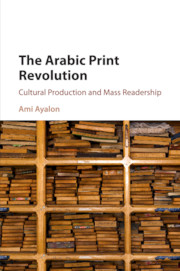Book contents
- Frontmatter
- Dedication
- Contents
- Preface and Acknowledgments
- Introduction
- 1 The Formative Phase of Arab Printing: A Historical Overview
- 2 Printers and Publishers
- 3 Books, Journals, Cartes de visite
- 4 Diffusion Channels
- 5 Advancing Circulation
- 6 Reading and Readers
- 7 Reading in Public
- Conclusion
- Bibliography
- Index
5 - Advancing Circulation
Published online by Cambridge University Press: 05 September 2016
- Frontmatter
- Dedication
- Contents
- Preface and Acknowledgments
- Introduction
- 1 The Formative Phase of Arab Printing: A Historical Overview
- 2 Printers and Publishers
- 3 Books, Journals, Cartes de visite
- 4 Diffusion Channels
- 5 Advancing Circulation
- 6 Reading and Readers
- 7 Reading in Public
- Conclusion
- Bibliography
- Index
Summary
New Conduits: Mail Delivery and Distribution Agents
Bookshops and libraries multiplied in the region, but they were not opened everywhere. For many potential readers, the nearest such outlet was in another town, sometimes a remote one, and practically beyond reach. Despite their ongoing expansion, bookshops, libraries, and reading rooms were too few and far between to make printed publications accessible across the region. Looking for new channels to complement the old, publishers had two more options at their disposal, both facilitated by the changes in communications: sending the published items to clients' homes by mail and selling them through itinerant agents, who were positioned in or traveled around faraway places. Both books and journals were thus circulated.
From very early on, books advertised in newspapers were announced to be “available at the paper's office.” The standard formula in book adverts was “yubāᶜ fī …” (on sale at …) or “yuṭlab min …” (to be requested from …) followed by reference to the paper's bureau. Sometimes this was the only way to get the book; at other times, it was obtainable there in addition to some shops or sellers. Let us look at some examples. We will recall that Ibrāhīm al-Najjār's Miṣbāḥ al-sārī, which was sold by several merchants in Beirut, Damascus, and Aleppo, was also available at the office of Ḥadīqat al-Akhbār, the newspaper advertising it. This routine became standard until the end of the century, and occasionally beyond. Journal mediation in bookselling was sometimes expanded into a “sales section,” whereby newspapers publicized lists of printed works, not just single items, available in their office. More ambitious journals, like al-Jinān, Lisān al-Ḥāl, and al-Hilāl, opened what seem to have been full-fledged promotional wings in their offices. Similarly, readers were advised to order books directly from the press that printed them, or straight from the author, whose name was frequently noted without an address. Thus, a book on the history of Damascus, printed in that city in 1879, was available “from the author in Damascus” (ᶜinda al-mu'allif fī al-shām) with no further particulars; a book on religious faith, printed in 1897, “should be requested (yuṭlab) from its author in Manṣūra”; and a religious tract printed in 1899 was to be “ordered from its esteemed writer in Suez.”
- Type
- Chapter
- Information
- The Arabic Print RevolutionCultural Production and Mass Readership, pp. 123 - 153Publisher: Cambridge University PressPrint publication year: 2016



